Different Types of Business Transactions and Accounting Principles
Added on 2022-11-28
29 Pages4091 Words320 Views
HNBS 310 FINANCIAL
ACCOUNTING
ACCOUNTING
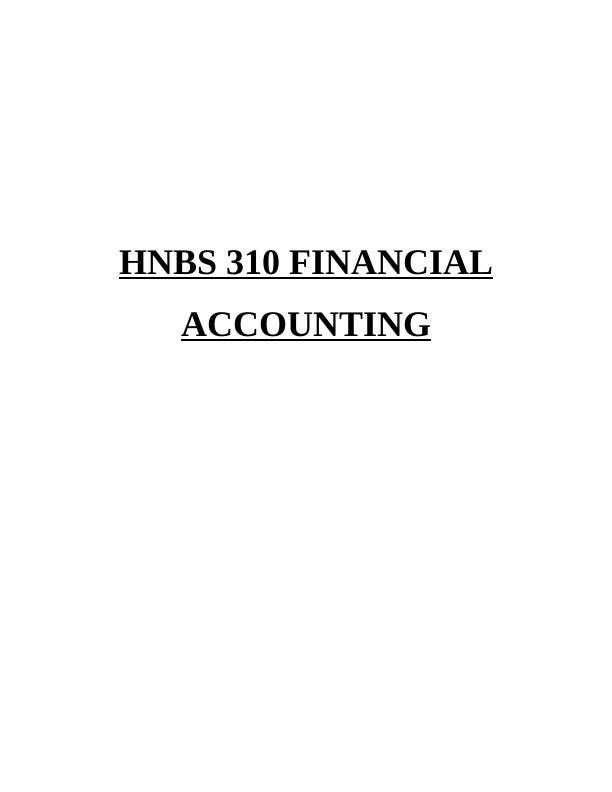
TABLE OF CONTENTS
Scenario 1........................................................................................................................................3
Q1. Business transaction’s different types..................................................................................3
Question: 2.......................................................................................................................................4
1. Journal entries..........................................................................................................................4
2. Ledger accounts.......................................................................................................................7
3. Trial Balance............................................................................................................................9
Q3. Difference between financial statement and report............................................................10
Q4. Different accounting basic principles.................................................................................11
Q5..............................................................................................................................................12
Q6..............................................................................................................................................14
Q7. Cash flow statement............................................................................................................15
Scenario 2......................................................................................................................................16
Question: 1.....................................................................................................................................16
Q2. Control accounts.................................................................................................................17
Question: 3.....................................................................................................................................18
Question: 4.....................................................................................................................................19
Question: 5.....................................................................................................................................20
REFERENCES..............................................................................................................................21
Scenario 1........................................................................................................................................3
Q1. Business transaction’s different types..................................................................................3
Question: 2.......................................................................................................................................4
1. Journal entries..........................................................................................................................4
2. Ledger accounts.......................................................................................................................7
3. Trial Balance............................................................................................................................9
Q3. Difference between financial statement and report............................................................10
Q4. Different accounting basic principles.................................................................................11
Q5..............................................................................................................................................12
Q6..............................................................................................................................................14
Q7. Cash flow statement............................................................................................................15
Scenario 2......................................................................................................................................16
Question: 1.....................................................................................................................................16
Q2. Control accounts.................................................................................................................17
Question: 3.....................................................................................................................................18
Question: 4.....................................................................................................................................19
Question: 5.....................................................................................................................................20
REFERENCES..............................................................................................................................21
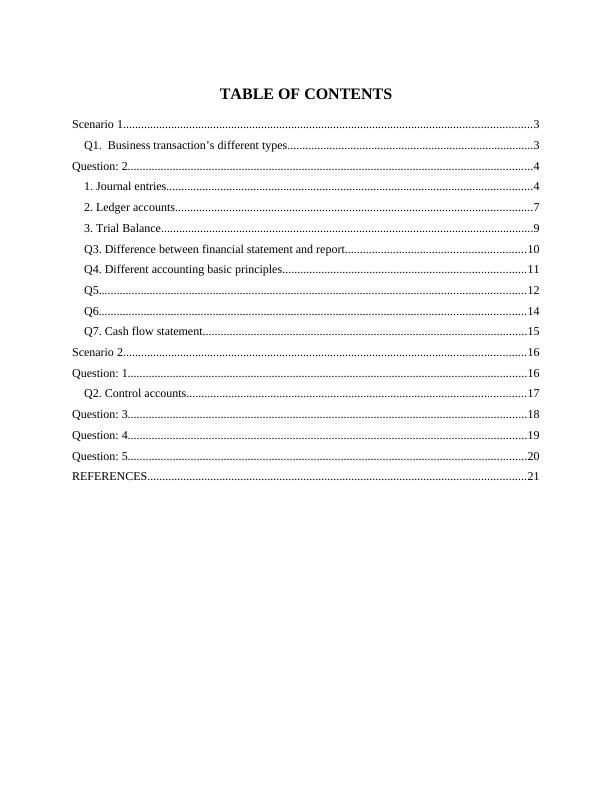
Scenario 1
Q1. Business transaction’s different types
Purchase of materials and goods: They may be for credit or cash. The cash purchases are paid in
an immediate manner and are not found easily in many businesses. The purchases are for goods
and materials are business transactions in every business. The credit purchases are paid after
some time.
Purchasing services: The purchasing services have example as repair to equipment, advertising
and printing costs (Bradlow and Finkelstein, 2018).
Sales: Cash sales are paid immediately for instance in shops. The credit sales are paid later after
taking in consideration allotted credit period.
Paying wage and salaries: Salaries are paid to the staff.
Non-current assets being purchased.
Raising of finance and payment of reward to finance suppliers. For instance, owners investing in
capital or loan being taken from financial institutions.
Accounting and payment of tax.
Movement of money in account of bank.
Single entry system
The system deals with single sided aspect of transaction. The system realises cash and personal
items related to the transactions as it ignores the items which are impersonal. Thus, there are
chances of inaccuracy in it.
Double entry system
This system of book keeping records the two aspect of business transaction which have been
recorded for double-entry book keeping. This system records the two sides one of debit and
credit in every transaction of business in value equalling.
Trial Balance and its importance
Q1. Business transaction’s different types
Purchase of materials and goods: They may be for credit or cash. The cash purchases are paid in
an immediate manner and are not found easily in many businesses. The purchases are for goods
and materials are business transactions in every business. The credit purchases are paid after
some time.
Purchasing services: The purchasing services have example as repair to equipment, advertising
and printing costs (Bradlow and Finkelstein, 2018).
Sales: Cash sales are paid immediately for instance in shops. The credit sales are paid later after
taking in consideration allotted credit period.
Paying wage and salaries: Salaries are paid to the staff.
Non-current assets being purchased.
Raising of finance and payment of reward to finance suppliers. For instance, owners investing in
capital or loan being taken from financial institutions.
Accounting and payment of tax.
Movement of money in account of bank.
Single entry system
The system deals with single sided aspect of transaction. The system realises cash and personal
items related to the transactions as it ignores the items which are impersonal. Thus, there are
chances of inaccuracy in it.
Double entry system
This system of book keeping records the two aspect of business transaction which have been
recorded for double-entry book keeping. This system records the two sides one of debit and
credit in every transaction of business in value equalling.
Trial Balance and its importance
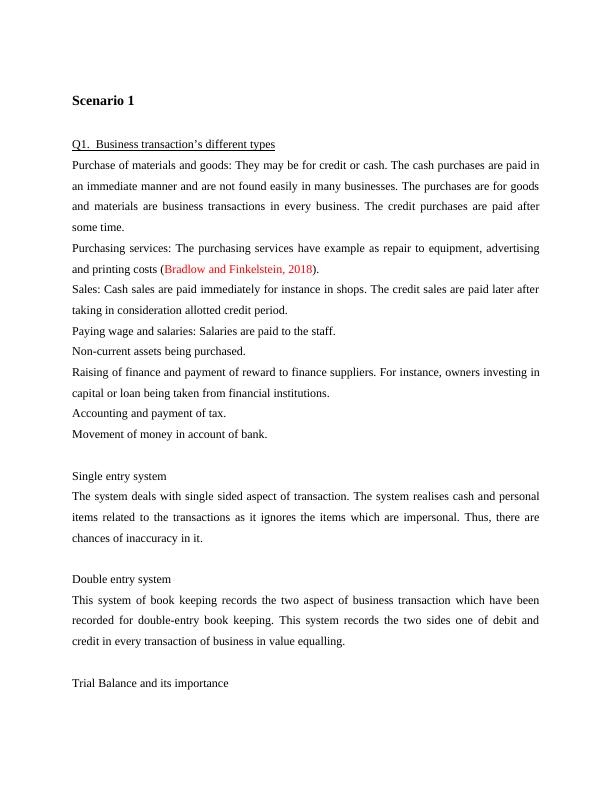
It provides a check on
the process of double
entry, which ensures
that for every
corresponding debit
there is a credit of same
value. It generally picks
up on many of the
errors, however not all.
The ledger accounts
balance is set out and is
used in the preparation
of financial statements
(Bradlow and
Finkelstein, 2018).
Question: 2
1. Journal entries
2. Ledger accounts
Capital account
Date Particulars Amount Date Particulars Amount
1/6/2016 By Bank
account
65000
30/6/16 To Balance carry forward 65000
Cash account
Date Particulars Amount Date Particulars Amount
7/6/2016 To Sales 4000 18/6/16 By Computer equipment account 3000
Date Particulars Debit Credit
1/6/16 Cash account Dr 65000
To capital account 65000
(Started business by
introducing capital)
2/6/16 Purchase account Dr 8000
To Accounts Payable account 8000
(credit purchase of goods)
7/6/16 Cash account Dr 4000
To Sales account 4000
(cash sales of ¼ inventories)
8/6/16 Accounts Payable account 4000
To Bank account 4000
( 1/2 of the payment for credit
purchase of goods has been
made)
14/6/16 Insurance account Dr 75
To Bank account 75
(issuance of cheque for
paying monthly insurance)
15/6/16 Accounts receivables account
Dr
12000
To Sales account 12000
(Remaining inventories sold
on credit)
16/6/16 Purchase account Dr 10000
To Accounts Payables
account
10000
(Credit purchase of goods)
18/6/16 Computer equipment account
Dr
3000
To Cash account 3000
(Purchase of computer
equipment for cash)
20/6/16 Rent account Dr 150
To Bank account 150
(Cheque issued for rent
payment)
the process of double
entry, which ensures
that for every
corresponding debit
there is a credit of same
value. It generally picks
up on many of the
errors, however not all.
The ledger accounts
balance is set out and is
used in the preparation
of financial statements
(Bradlow and
Finkelstein, 2018).
Question: 2
1. Journal entries
2. Ledger accounts
Capital account
Date Particulars Amount Date Particulars Amount
1/6/2016 By Bank
account
65000
30/6/16 To Balance carry forward 65000
Cash account
Date Particulars Amount Date Particulars Amount
7/6/2016 To Sales 4000 18/6/16 By Computer equipment account 3000
Date Particulars Debit Credit
1/6/16 Cash account Dr 65000
To capital account 65000
(Started business by
introducing capital)
2/6/16 Purchase account Dr 8000
To Accounts Payable account 8000
(credit purchase of goods)
7/6/16 Cash account Dr 4000
To Sales account 4000
(cash sales of ¼ inventories)
8/6/16 Accounts Payable account 4000
To Bank account 4000
( 1/2 of the payment for credit
purchase of goods has been
made)
14/6/16 Insurance account Dr 75
To Bank account 75
(issuance of cheque for
paying monthly insurance)
15/6/16 Accounts receivables account
Dr
12000
To Sales account 12000
(Remaining inventories sold
on credit)
16/6/16 Purchase account Dr 10000
To Accounts Payables
account
10000
(Credit purchase of goods)
18/6/16 Computer equipment account
Dr
3000
To Cash account 3000
(Purchase of computer
equipment for cash)
20/6/16 Rent account Dr 150
To Bank account 150
(Cheque issued for rent
payment)
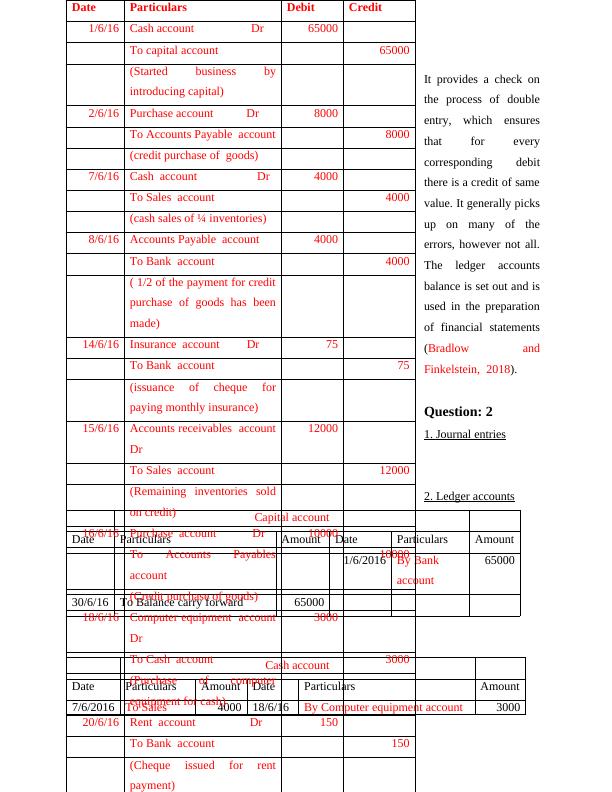
account
21/6/16 To Sales
account
10000 30/6/16 By Stationary account 30
25/6/16 To Bank
account
100 30/6/16 By Balance carry forward 11070
Bank account
Date Particulars Amount Date Particulars Amount
1/6/2016 To Capital
account
65000 8/6/2016 By Accounts Payable
account
4000
14/6/2016 By Insurance account 75
20/6/16 By Rent account 150
25/6/16 By Cash account 100
30/6/16 By Balance carry forward 60675
Purchase account
Date Particulars Amount Date Particulars Amount
2/6/2016 To Accounts Payable
account
8000
16/6/16 To Accounts Payables
account
10000 30/6/16 By Balance carry forward 18000
Sales account
Date Particulars Amount Date Particulars Amount
7/6/2016 By Cash account 4000
15/6/16 By Accounts receivables
account
12000
30/6/16 To Balance carry 26000 21/6/16 By Cash account 10000
21/6/16 To Sales
account
10000 30/6/16 By Stationary account 30
25/6/16 To Bank
account
100 30/6/16 By Balance carry forward 11070
Bank account
Date Particulars Amount Date Particulars Amount
1/6/2016 To Capital
account
65000 8/6/2016 By Accounts Payable
account
4000
14/6/2016 By Insurance account 75
20/6/16 By Rent account 150
25/6/16 By Cash account 100
30/6/16 By Balance carry forward 60675
Purchase account
Date Particulars Amount Date Particulars Amount
2/6/2016 To Accounts Payable
account
8000
16/6/16 To Accounts Payables
account
10000 30/6/16 By Balance carry forward 18000
Sales account
Date Particulars Amount Date Particulars Amount
7/6/2016 By Cash account 4000
15/6/16 By Accounts receivables
account
12000
30/6/16 To Balance carry 26000 21/6/16 By Cash account 10000
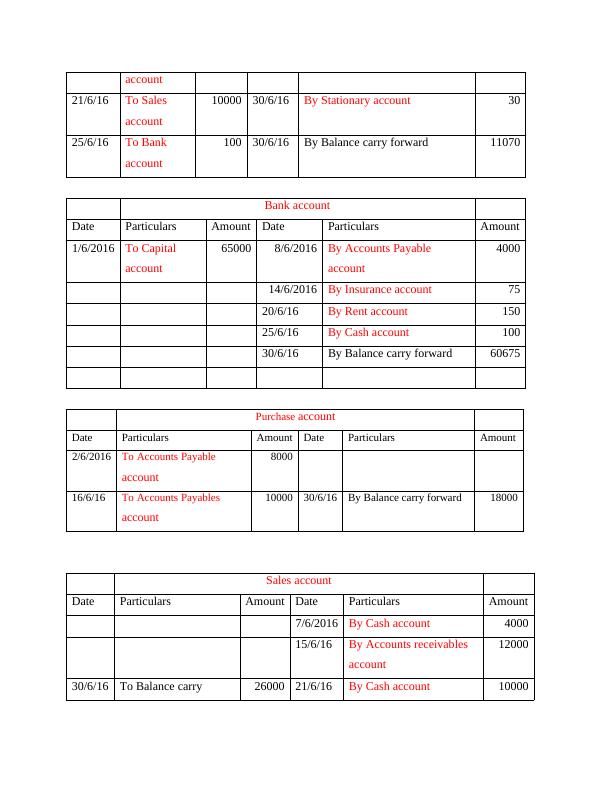
forward
Accounts payables account
Date Particulars Amount Date Particulars Amount
8/6/2016 To Bank account 4000 2/6/2016 By Purchase
account
8000
30/6/16 To balance forward 14000 16/6/16 By Purchase
account
10000
Accounts receivables
Date Particulars Amount Date Particulars Amount
15/6/16 To Sales
account
12000 30/6/16 By balance carry forward 12000
Insurance account
Date Particulars Amount Date Particulars Amount
14/6/16 To Bank
account
75 30/6/16 By balance carry forward 75
Computer Equipment account
Date Particulars Amount Date Particulars Amount
18/6/16 To Cash
account
3000 30/6/16 By balance carry forward 3000
Rent account
Date Particulars Amount Date Particulars Amount
20/6/16 To Bank
account
150 30/6/16 By balance carry forward 150
Stationary account
Accounts payables account
Date Particulars Amount Date Particulars Amount
8/6/2016 To Bank account 4000 2/6/2016 By Purchase
account
8000
30/6/16 To balance forward 14000 16/6/16 By Purchase
account
10000
Accounts receivables
Date Particulars Amount Date Particulars Amount
15/6/16 To Sales
account
12000 30/6/16 By balance carry forward 12000
Insurance account
Date Particulars Amount Date Particulars Amount
14/6/16 To Bank
account
75 30/6/16 By balance carry forward 75
Computer Equipment account
Date Particulars Amount Date Particulars Amount
18/6/16 To Cash
account
3000 30/6/16 By balance carry forward 3000
Rent account
Date Particulars Amount Date Particulars Amount
20/6/16 To Bank
account
150 30/6/16 By balance carry forward 150
Stationary account

End of preview
Want to access all the pages? Upload your documents or become a member.
Related Documents
Financial Accounting: Principles, Transactions, and Statementslg...
|31
|4629
|327
Accounting: Business Transactions, Financial Statements, Fundamental Principleslg...
|26
|4285
|155
Financial Accounting Projectlg...
|10
|2071
|369
Financial Accounting: Concepts and Principleslg...
|25
|4323
|68
FINANCIAL ACCOUNTING TABLE OF CONTENTSlg...
|18
|3952
|92
Financial Accounting Assignment Solutionlg...
|12
|1352
|66
